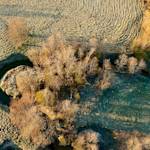Patagonian and Andean Steppe
2023 CE • Argentina, Chile
"A rugged, vast landscape shaped by ancient volcanoes and incessant winds, the steep mountains, deep canyons, and high plateaus of the Patagonian and Andean steppe harbor a unique wildlife community. The 270,000-square-mile Patagonian Steppe is the last stronghold of the guanaco, including the world’s largest migratory population of guanacos, and is home to the southernmost population of the endangered Andean cat, Darwin’s rhea, Andean condor, many endemic species of plants and lizards, and tens of thousands of swans, flamingos, and upland geese . . . Although seemingly wild and timeless, human activities have greatly altered Argentina’s steppes. Guanacos and vicuñas were the main source of food for pumas and Andean condors, and their grazing shaped the landscape. Today, these camelid populations have been greatly reduced by hunting and competition for food with sheep and goats, and water birds such as flamingos and red shovelers have lost their wetland nesting habitat to livestock grazing. Pumas, with the paucity of native prey, today prey heavily on livestock. This can be catastrophic to livestock producers, who kill all carnivores in retaliation, including the globally endangered Andean cat. Construction of more than 25,000 miles of oil exploration roads has exposed previously inaccessible areas to illegal hunting. Many destructive activities are allowed inside reserves, leaving them vulnerable to threats from exploration and extraction of oil and minerals and livestock grazing."
"Patagonian and Andean Steppe," WCS Argentina.
Image: Jason Hollinger, CC BY 2.0, via Wikimedia Commons


Learn about Maya Lin’s fifth and final memorial: a multi-platform science based artwork that presents an ecological history of our world - past, present, and future.

Discover ecological histories and stories of former abundance, loss, and recovery on the map of memory.

Learn how we can reduce our emissions and protect and restore species and habitats – around the world.

See how art can help us rethink the problems we face, and give us hope that each one of us can make a difference.

Help make a global memorial something personal and close to home. Share your stories of the natural world.


